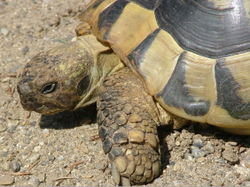Reptile Guide
Reptile |
Agamidae |
Archosaurs |
Avicephalans |
Fictional reptiles |
Lepidosaurs |
Marine reptiles |
Parareptiles |
Pet reptiles |
Turtle |
License
|
Reptile world, all about our cold blooded friends
|
HOME |
Reptiles
Fossil range: Carboniferous - Recent |

Eastern Hermann's Tortoise
|
|
Scientific classification |
| Kingdom: |
Animalia
|
| Phylum: |
Chordata
|
| Subphylum: |
Vertebrata
|
| Class: |
Sauropsida
Goodrich, 1916 |
|
|
Orders |
|
|
Reptiles
Reptiles are
tetrapods and amniotes, animals whose embryos are surrounded
by an amniotic membrane. Today they are represented by four surviving
orders:
Reptiles are found on every
continent except for Antarctica, although their main
distribution comprises the tropics and subtropics. Though
all cellular metabolism produces some heat, most modern
species of reptiles do not generate enough to maintain a
constant body temperature and are thus referred to as
"cold-blooded" or ectothermic (the Leatherback Sea Turtle is
an exception). Instead, they rely on gathering and losing
heat from the environment to regulate their internal
temperature, e.g, by moving between sun and shade, or by
preferential circulation — moving warmed blood into the body
core, while pushing cool blood to the periphery. In their
natural habitats, most species are adept at this, and can
ususally maintain core body temperatures within a fairly
narrow range, comparable to that of mammals and
birds, the two surviving groups of "warm-blooded"
animals. While this lack of adequate internal heating
imposes costs relative to temperature regulation through
behavior, it also provides a large benefit by allowing
reptiles to survive on much less food than comparably-sized mammals and birds, who burn
much of their food for warmth. While warm-blooded animals
move faster in general, an attacking lizard, snake or
crocodile moves very quickly.
Except for a few members of the Testudines, all reptiles
are covered by scales.
Most reptile species are
oviparous (egg-laying). Many species of squamates, however,
are capable of giving live birth. This is achieved, either
through ovoviviparity (egg retention), or viviparity (babies
born without use of calcified eggs). Many of the viviparous
species feed their fetuses through various forms of placenta
analogous to those of mammals (Pianka & Vitt, 2003 pgs:
116-118). They often provide considerable initial care for
their hatchlings.
Reptiles, amphibians, snakes, frogs, marine reptiles, squamata, agamidae, snake scales, snakes head, reptile scales,lizards, snakes, amphibians reptiles, anfibios, ball python, bearded dragon, chameleons, corn snake, garter snakes, geckos, iguanas,leopard geckos, mamiferos, pet reptiles, poisonous, rattle, serpientes
